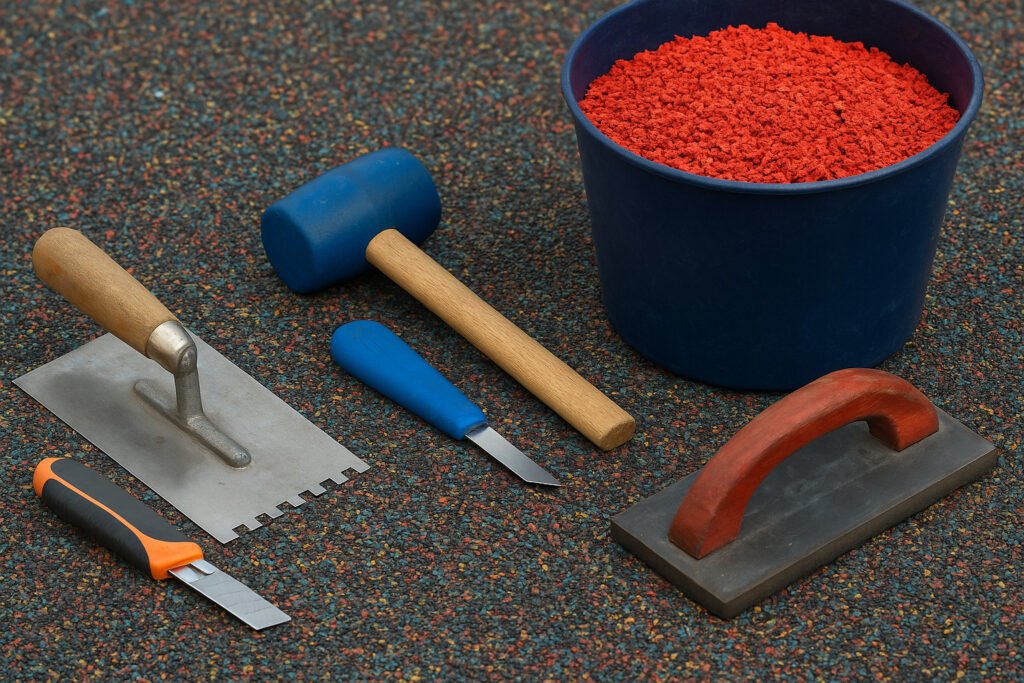EPDM Rubber Flooring Installation Tools – What You Need for a Smooth Project
Installing EPDM rubber flooring in playgrounds, kindergartens, or running tracks requires more than just high-quality granules. The right tools ensure a smooth, durable, and safe surface that complies with international safety standards.
This article outlines the essential tools for EPDM installation and provides recommendations for contractors.

1. Surface Preparation Tools
A strong foundation is key to a long-lasting EPDM surface.
- Broom or Blower – clears away dust and debris.
- Vacuum Cleaner – removes fine particles for a perfectly clean base.
- Measuring Tape & Laser Level – ensures correct slope and uniform thickness.
- Cutting Knife / Cutter Machine – trims edges and corners neatly.
2. Mixing & Proportioning Tools
Binder ratios directly affect the elasticity and durability of the flooring.
- Mixing Machine – blends EPDM granules with PU (polyurethane) binder.
- Mixing Buckets / Drums – stainless steel preferred for long-term use.
- Electronic Scale – measures accurate PU ratio (commonly 22%).
🔗 Authority link: European Standards for Impact-Absorbing Playground Surfacing (EN1177)
3. Laying & Leveling Tools
Even application ensures both safety and aesthetics.
- Trowels / Hand Tools – spread EPDM evenly.
- Roller – compacts the surface to prevent bubbles.
- Power Trowel – recommended for large-scale projects to guarantee smoothness.
4. Safety & Auxiliary Equipment
Contractors should always prioritize safety.
- Protective Gloves, Masks, and Goggles – avoid contact with PU binder.
- Solvent / Cleaning Agent – removes residue from tools.
- Tarpaulin / Waterproof Cover – protects uncured surfaces from sudden rain.
5. Recommended Contractor Toolkit
Quick Checklist:
- Preparation: broom, blower, cutter, laser level
- Mixing: mixer, electronic scale, stainless steel bucket
- Laying: trowel, roller, power trowel
- Safety: gloves, masks, goggles, tarpaulin
❓ FAQ – EPDM Installation Tools
Q1: Can I install EPDM flooring without a power trowel?
A: For small areas, hand tools and rollers are sufficient. For larger projects, a power trowel is recommended to save time and improve consistency.
Q2: What is the most critical tool for EPDM installation?
A: The mixing machine and electronic scale are essential, as proper binder ratios directly impact durability and safety.
Q3: How do I clean tools after using PU binder?
A: Use a specialized solvent or cleaning agent immediately after mixing, before the binder cures.
Q4: Do I need safety equipment during EPDM installation?
A: Yes, protective gloves, goggles, and masks are highly recommended to avoid skin contact and inhalation of PU binder fumes.
✅ Conclusion
The success of an EPDM installation depends heavily on using the right tools. From preparation to curing, each step requires precision to guarantee safety, performance, and long-term durability.
At Lanhefloor, we supply high-quality EPDM granules along with professional technical guidance for contractors worldwide.
📩 Looking for EPDM flooring solutions for your next project?
Request a Quote Now and get tailored advice, samples, and competitive pricing directly from our factory.
📚 Related Blogs
- EPDM Rubber Flooring Installation Guide
- How to Install Rubber Flooring on Concrete
- EPDM vs. PU for Outdoor Flooring – Which is Better?
- Top Mistakes to Avoid When Installing Rubber Flooring
